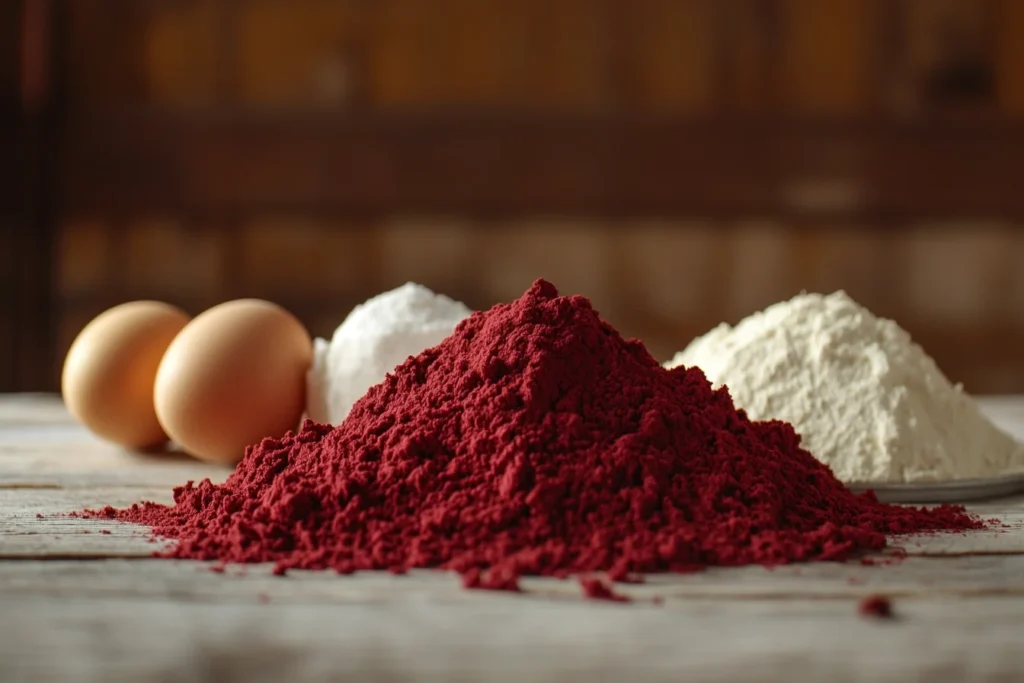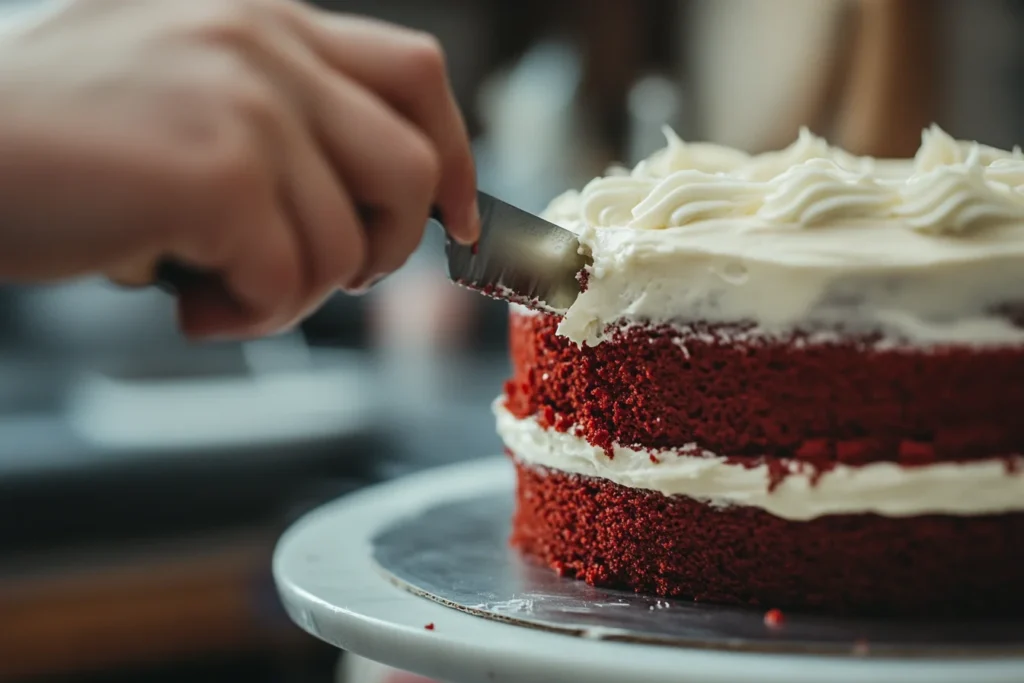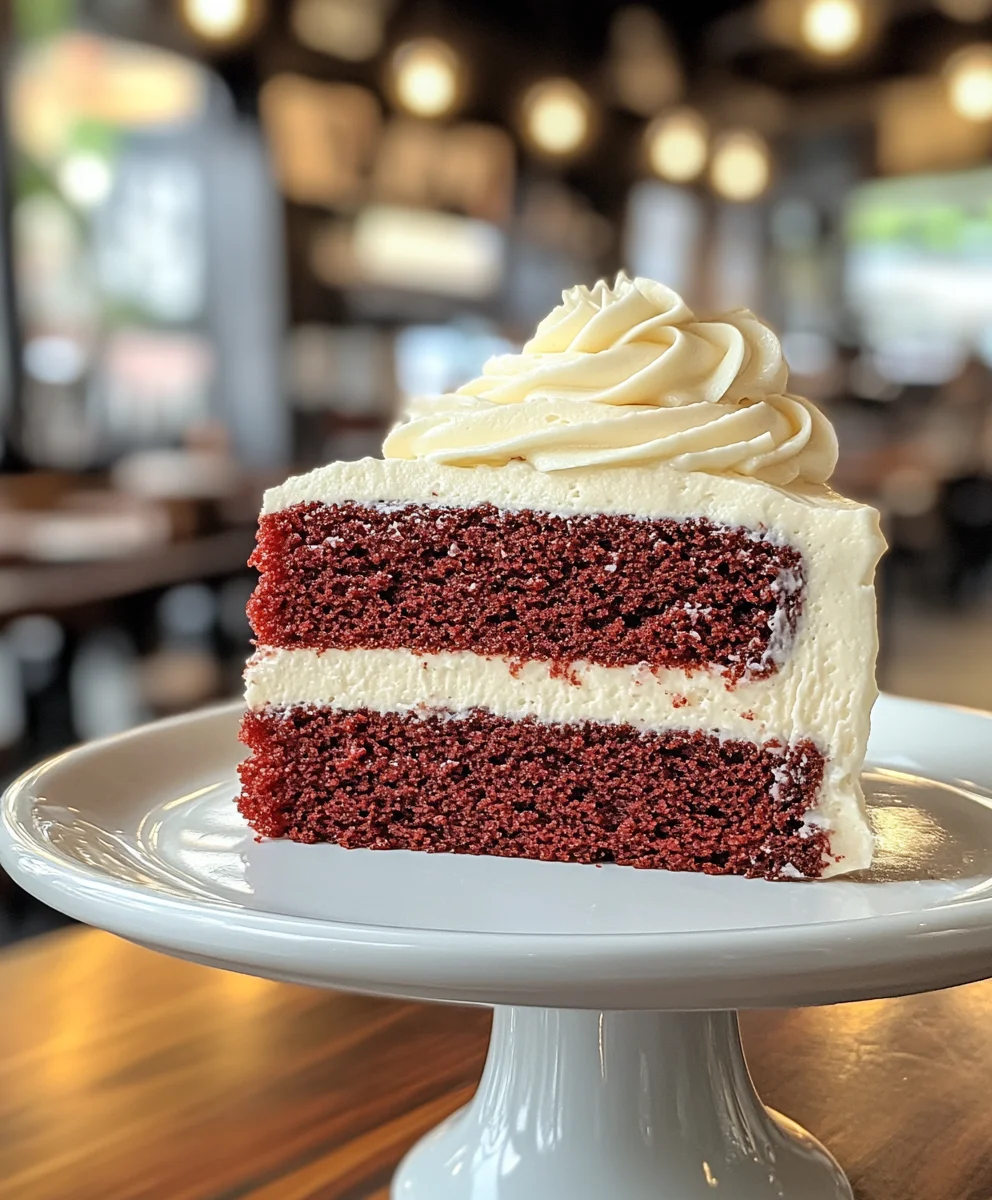Table of Contents
Introduction
Red velvet cake – just the name evokes images of rich, crimson layers, creamy frosting, and a taste that’s both decadent and slightly mysterious. It’s a classic for a reason, appearing at countless celebrations and special occasions. But have you ever stopped to wonder, “What is red velvet cake made of?” It’s not just a chocolate cake dyed red, folks. There’s a specific science and combination of ingredients that give this cake its unique taste, texture, and color. So, let’s explore the secrets behind this beloved dessert.
The Core Components: What’s Inside a Red Velvet Cake?
At its heart, red velvet cake is a delicate balance of ingredients that create its signature characteristics. Therefore, understanding these key components is crucial to understanding why red velvet cake is so unique. Also, it is important to use high quality ingredients to achieve the best results. The quality of the ingredients will impact the overall flavor, texture and appearance of the final product.
- Flour: All-purpose flour or cake flour provides the structure for the cake. The flour is crucial for creating a stable base for the other ingredients.
- Sugar: Granulated sugar adds sweetness and helps keep the cake moist. Furthermore, the sugar helps to tenderize the cake.
- Butter or Oil: Adds richness and tenderness. Similarly, both oil and butter help to create a moist and tender texture, however, they will affect the taste in a different way.
- Cocoa Powder: Unsweetened cocoa powder lends a subtle chocolate flavor and contributes to the cake’s color. Not only that, but the acidity of the cocoa powder helps to create the unique flavor of the cake.
- Buttermilk: Adds tanginess and helps create a tender crumb. Also, buttermilk reacts with baking soda which enhances the lift of the cake. In addition, the buttermilk contributes to the overall moistness of the cake.
- Eggs: Provide structure and richness. Furthermore, eggs help to emulsify the ingredients, creating a smoother batter, which results in a more consistent texture.
- Baking Soda: A leavening agent, essential for lift and texture. The baking soda is responsible for the light and airy texture of the cake.
- Vinegar: A small amount of vinegar reacts with baking soda to create a light and fluffy texture, and also enhances the red hue. In addition, it also contributes to the unique tang that the cake is known for.
- Red Food Coloring: Traditionally, this is what gives the cake its signature red color. However, the amount of red food coloring can be adjusted based on your preferences. Some recipes also use natural food colorings like beet juice, instead of red food coloring.
Besides these main components, some recipes include vanilla extract or other flavorings to enhance the overall taste. Consequently, there is a wide range of recipes and variations that can be used when making red velvet cake. For example, some recipes use coffee to enhance the chocolate flavors, or lemon zest to add brightness to the recipe.
The Role of Each Ingredientfin

To truly understand what makes a red velvet cake, let’s explore the function of each ingredient in more detail:
- Cocoa Powder: Unlike a chocolate cake where cocoa is the dominant flavor, in red velvet, it plays a supporting role. It provides a subtle chocolate flavor that balances the other flavors. Also, the acidity of the cocoa also contributes to the cake’s red hue. The type of cocoa you use can also alter the color and the flavor of the cake, for example, dutch-processed cocoa has a more mellow flavor than natural cocoa powder.
- Buttermilk: This ingredient is the secret to red velvet’s signature tanginess and tender crumb. Buttermilk reacts with baking soda, creating a light and fluffy texture. Also, the acidity of the buttermilk reacts with the cocoa, further enhancing the red hue. The fat content of the buttermilk can also affect the final texture of the cake.
- Vinegar: A small amount of vinegar is added to react with the baking soda, boosting the lift and creating a lighter, airier texture. Additionally, vinegar also further enhances the red color, as well as contributing to the overall flavor. The type of vinegar that you use can also influence the final taste of the cake.
- Red Food Coloring: While the other ingredients contribute to the reddish hue, red food coloring is what really gives the cake its vibrant crimson color. However, many people have started experimenting with natural food colorings such as beet juice, as previously mentioned. The type of red food coloring you use can also affect the overall shade of red in the cake.
- Fat Source (Butter or Oil): Whether you use butter or oil, it’s essential to add richness, moisture, and a tender crumb to the cake. Oil will result in a more moist cake, since it is liquid at room temperature. On the other hand, butter will provide a slightly richer flavor. Furthermore, it can also influence the texture of the cake.
Therefore, each of these ingredients plays a vital role in the overall taste, texture, and appearance of the final product. Consequently, it is important to use high quality ingredients for the best results. Also, using the correct measurements is important for the balance of ingredients.
The Science Behind the Red Hue: Where Does the Color Come From?

The signature crimson color of red velvet cake has sparked much curiosity. The combination of ingredients and their chemical reactions contribute to the unique color. Earlier, the color was not as vibrant as it is today, since the processing of the cocoa powder has changed over time.
The Original Reaction: Cocoa and Acid
The original red velvet cake recipes utilized a reaction between natural cocoa powder (which is acidic), buttermilk, and vinegar which, when combined with baking soda, created a reddish hue. This reaction creates a natural red color which is what gave the cake its name. However, the color is not as vivid as it is today. Therefore, when the recipe first came out, the color was not the same vibrant red that it is known for today.
The Evolution: The Addition of Red Food Coloring
As cocoa powder became more processed, it lost some of its acidity which resulted in less of the reddish color. Consequently, red food coloring was added to enhance the color and to make it more vibrant. Therefore, red food coloring is now considered an essential part of the recipe, and the ingredient that gives the cake the classic and vibrant red color that it is known for. While the original reaction still occurs, the amount of redness is not as strong without the red food coloring.
Natural Food Coloring Alternatives
- Beetroot Juice or Powder: Provides a natural red color, and also adds a touch of earthy flavor, although it may not be as vibrant as the use of red food coloring. Since it is a natural coloring, it may result in a different color that the original cake, but it is a good alternative for those that do not want to use artificial coloring.
- Pomegranate Juice or Powder: Another natural option, offering a slightly different hue. Also, it may not provide the same level of color saturation as other options. It may result in a more pink color, rather than the traditional red.
- Red Beet Powder: This will give the cake a natural red hue, with no artificial coloring. The powder also has a more subtle flavor than beet juice.
These natural options offer an alternative to artificial dyes, but the intensity of color may vary. Therefore, it is important to experiment to find a natural option that works best for you. Also, many natural food coloring options tend to fade while baking, so you might need to use more than you would an artificial food coloring.
The Texture: What Makes Red Velvet So Delightful?
Beyond its color, red velvet cake also boasts a unique texture. It’s not quite as dense as a chocolate cake, yet not as light as a typical vanilla cake. It is the perfect balance of both, which is part of the reason why it is so popular. The texture is an important part of what makes this cake so appealing.
A Fine and Tender Crumb
The combination of buttermilk, vinegar, and the precise ratio of wet to dry ingredients creates a fine, delicate crumb that melts in your mouth. The ingredients work in tandem to create a soft, and moist texture. Also, the buttermilk and the acid in the vinegar are crucial components to the tenderness of the crumb.
Moist and Velvety
The use of oil, or butter in the recipe ensures that the cake is moist. The addition of fat also keeps the cake tender and prevents it from drying out. Also, the use of buttermilk further contributes to the overall moistness of the cake, since it adds a layer of fat and moisture. The amount of liquid in the recipe also contributes to the moistness of the cake.
Not Too Dense, Not Too Light
Red velvet cake walks the line perfectly between being dense and airy. It has a satisfying bite but is still very light and fluffy. Therefore, it provides the perfect balance of texture, which is why it is such a crowd pleaser. Consequently, the texture plays a significant part in why this cake is so popular. Also, the mixing method is also important to achieve the right balance of texture.
Nutritional Considerations of Red Velvet Cake
While incredibly delicious, red velvet cake is a dessert, so let’s be mindful of its nutritional profile. Furthermore, it is always important to consume foods in moderation, especially foods that are high in calories, sugar and fat.
Typical Nutritional Data Per Slice (1/8 of a 9-inch cake)
| Nutrient | Amount |
| Calories | 300-400 |
| Total Fat | 15-20 g |
| Saturated Fat | 8-10 g |
| Cholesterol | 80-100 mg |
| Sodium | 200-300 mg |
| Total Carbohydrate | 40-50 g |
| Dietary Fiber | 1-2 g |
| Sugar | 30-40 g |
| Protein | 3-5 g |
These values are approximate and can vary depending on the specific recipe and serving size. However, it’s clear that red velvet cake is a higher calorie, higher fat, and higher sugar treat. Additionally, the type of frosting that is used, can also influence these values. For example, some recipes have more sugar than others, and this will greatly influence the overall sugar content.
Moderation is Key
- Sugar: The high sugar content is a primary concern, contributing to empty calories and potential health issues if consumed excessively. Therefore, it is important to eat this treat in moderation. Also, excessive amounts of sugar can cause blood sugar spikes, and can have many other negative effects on the body.
- Fat: Red velvet cake is high in fat, particularly saturated fat, which can increase cholesterol levels and risk of heart disease if consumed frequently. Consequently, it is important to be aware of the fat levels, and adjust your consumption based on your personal health goals. Furthermore, it is important to prioritize unsaturated fats over saturated fats.
- Portion Control: Enjoying a small slice of red velvet cake as an occasional treat is acceptable, but eating large portions can negatively impact your health goals. Furthermore, practicing portion control is essential to maintaining a healthy diet, and helps you enjoy your favorite foods in moderation.
Also, you can always explore healthier recipes or substitutions for ingredients. Therefore, you can enjoy your favorite treats while also making better choices. You can explore different recipes to find healthier alternatives.
Frosting: The Perfect Companion

No red velvet cake is complete without its signature frosting. The traditional choice is cream cheese frosting, but there are other variations that can be used. The frosting provides an important texture and flavor element to this cake.
Cream Cheese Frosting: The Classic Choice
The tangy flavor of cream cheese frosting perfectly complements the subtle chocolate and tanginess of the cake. The cream cheese adds a richness and creamy texture, that is both decadent and appealing. The slightly tangy flavor is a perfect balance to the sweetness of the cake. Also, the texture of the cream cheese frosting helps to provide a smooth finish that is both decadent and irresistible.
Other Frosting Options
- Ermine Frosting (Boiled Milk Frosting): A light, fluffy frosting made with a cooked flour base. It has a very light, marshmallow like texture, and is a great option if you want something less heavy than cream cheese frosting. Not only that, but it also has a lower sugar content than other options.
- Buttercream: A simple, classic frosting that offers a smooth, sweet taste. However, it may not have the same tanginess as the cream cheese frosting. It is a classic choice that pairs well with many different types of cake.
- Whipped Cream: For a lighter option, use a stabilized whipped cream, or a coconut whipped cream. Also, this is a great option if you are looking for something that is not as heavy as other frosting options. Furthermore, it is often a healthier alternative to other frosting options.
Therefore, the type of frosting you choose depends on your personal preference, and also on the type of taste you are trying to achieve. Also, you can always experiment with different flavor profiles to find the perfect pairing. You can also experiment with different flavors of frosting, such as vanilla, chocolate or a flavored extract.
FAQs About Red Velvet Cake Ingredients
Let’s address some of the common questions people have about the ingredients in red velvet cake. This section will help clarify some of the key differences between the cake and other similar desserts.
What gives red velvet cake its color?
Traditionally, red food coloring is used, but the combination of cocoa powder, buttermilk, and vinegar also contributes to the color. However, the use of red food coloring is usually what gives the cake its vibrant red color.
Is red velvet cake just chocolate cake?
No, while it contains cocoa powder, it has a different flavor profile and texture than a traditional chocolate cake. The overall flavor is more mild than chocolate cake, and the texture is also different.
Can I make red velvet cake without food coloring?
Yes, you can use natural alternatives like beetroot juice or powder, but the color may not be as vibrant. While this is an option, it is important to note that the resulting color may be slightly different.
Why is buttermilk used in red velvet cake?
Buttermilk adds tanginess, helps create a tender crumb, and reacts with baking soda for a light texture. Buttermilk is an important component to the unique flavor of this cake.
What does vinegar do in red velvet cake?
Vinegar reacts with baking soda, enhancing the cake’s lift, texture, and red hue. The vinegar also helps to further tenderize the cake.
Can I use oil instead of butter?
Yes, oil will make a more moist cake, while butter adds a slightly richer flavor. Both are good options, and the choice depends on your personal preferences.
Is cream cheese frosting the only frosting option?
No, you can use other frostings like buttercream, ermine frosting, or whipped cream. There are many different variations for the frosting, and the type that you choose can influence the final flavor of the cake.
How can I make red velvet cake healthier?
You can reduce the sugar and fat, substitute refined flours with whole grain versions, and use natural food coloring options. In addition to these options, you can also reduce the size of the serving you are consuming.
Conclusion: The Delectable Secrets of Red Velvet Cake
So, “What is red velvet cake made of?” It’s a delightful combination of cocoa powder, buttermilk, vinegar, and the right amount of fat, sugar and, traditionally, red food coloring, that gives this cake its unique taste, texture, and color. The subtle chocolate flavor, the moist and velvety crumb, and the signature cream cheese frosting make this cake truly exceptional. Whether you’re baking from scratch or simply enjoying a slice, understanding the ingredients helps to appreciate this classic dessert even more. So go ahead, enjoy a slice (in moderation, of course!) and savor all of the elements that make red velvet cake so special! Finally, happy baking!

